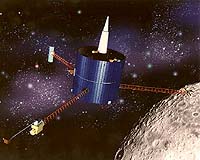 |
Sydeny, Australia (SPX) Aug 24, 2009 Whoever does it, and whenever it happens, spacecraft from Earth will be touching down on the Moon in the near future. Several nations have already announced plans for robot landers, and more could be announced in the years ahead. It's difficult to find safe ground to land on, as the crew of Apollo 11 can tell you. But one thing that also constrains landings is the need for a communications link to Earth. Some areas at the poles are at difficult angles to Earth, and the homeworld barely rises above the horizon. If you're on the far side, you can't see home directly at all. It's time to reconsider the idea of sending a communications satellite to the Moon. This has been proposed several times in the past, but it does not appear in most recent discussions of the future of spaceflight. A lunar comsat doesn't need to be large or heavy. Most landers don't require huge torrents of data to be sent back constantly. Autonomy in the landers would allow them to work by themselves, collect their data for transmission to Earth, then wait for the next flyover of the communications satellite. A small satellite could transmit to landers on the far side, then transmit back to Earth when it passed over the near side. This "store and forward" concept has already been demonstrated in amateur radio satellites. A polar orbiting satellite would provide good coverage of the poles, for obvious reasons. These are likely to be closely studied in the future, as scientists examine the ice deposits known to exist there. A realistic concept would be to use a large scientific orbiter as a relay, by including a communications payload alongside its regular instruments. This has already been done at Mars. Orbiters such as the long-lived Mars Global Surveyor and the currently active Mars Reconnaissance Orbiter have both served as links between Earth and spacecraft on the surface. The use of a communications satellite could also help to reduce the mass of landers on the near side with a clear line of sight to Earth. The less mass that has to be landed softly, the better. Communications is a power-hungry activity, and this could reduce the size of antennas as well as solar panels on a lander. Lunar orbiters are prone to shifts in their orbits from the Moon's somewhat irregular gravitational field, and also from the pull of the Earth and the Sun. But a small satellite would probably only need to work for a few months while the primary mission of a lander was carried out. Communications payloads on large orbiters would be kept aloft when the main spacecraft tuned its own orbit with its thrusters. Some type of international agreement would be needed to make effective use of a lunar communications satellite. The cost and construction could be shared between several nations. Data protocols would need to be fairly standardized to enable different spacecraft to use the same relay. The International Lunar Network, a proposed series of small scientific landers, paves the way for more work to be done on this subject. It is known that a relay satellite has already been proposed for this network, and the idea can clearly be applied beyond this series of missions. Without some type of communications satellite, many landing sites of scientific interest will be impossible to monitor. Dr Morris Jones is the author of "The New Moon Race", available from Rosenberg Publishing (www.rosenbergpub.com.au).
Share This Article With Planet Earth
Related Links - Mars News and Information at MarsDaily.com Lunar Dreams and more
 Microsats For The Moon
Microsats For The MoonSydney, Australia (SPX) Aug 20, 2009 For decades, microsatellites have been a boon to spaceflight. A small satellite can be built and launched fairly cheaply, sometimes hitching a ride for free aboard a large satellite launch. So far, microsatellites have not ventured very far into space. Could one go all the way to the Moon? Amateur groups have speculated on this possibility for years, but none have actually built a bird and ... read more |
|
| The content herein, unless otherwise known to be public domain, are Copyright 1995-2009 - SpaceDaily. AFP and UPI Wire Stories are copyright Agence France-Presse and United Press International. ESA Portal Reports are copyright European Space Agency. All NASA sourced material is public domain. Additional copyrights may apply in whole or part to other bona fide parties. Advertising does not imply endorsement,agreement or approval of any opinions, statements or information provided by SpaceDaily on any Web page published or hosted by SpaceDaily. Privacy Statement |